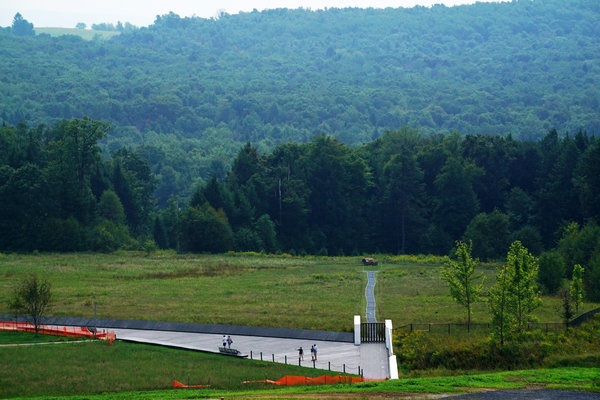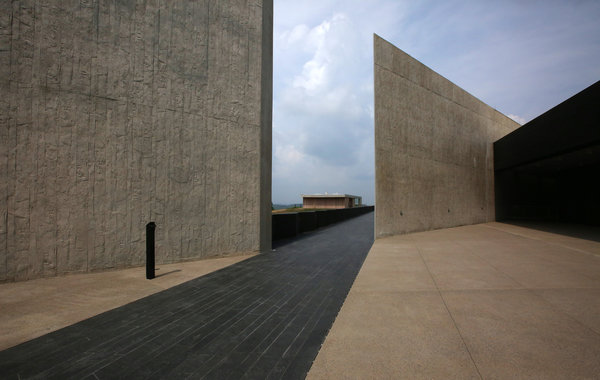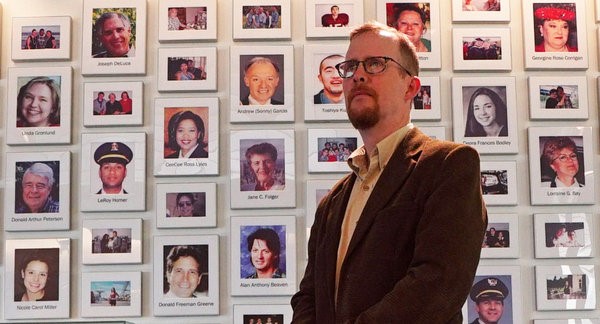A.J. Chavar New York Times
SHANKSVILLE, Pa. — Gordon W. Felt stood perfectly still, his head bowed slightly, as he listened to the frightened voices of three long-dead victims of Flight 93, their final words captured on answering machines just before the plane crashed into a reclaimed strip mine on the morning of September 11, 2001.
“That’s tough. That’s powerful,” Mr. Felt said, tears falling from his eyes during a visit to the new $26 million visitor center and museum that documents in wrenching detail the crash, which killed 40 passengers and crew members, including his brother Edward Porter Felt. “That will certainly make an impression.”

A view from the visitor center of the site where Flight 93 was forced down by passengers and crew members. Nicole Bengiveno The New York Times
Fourteen years after people on board the hijacked United Airlines flight forced the plane into the ground as terrorists aimed it toward Washington, their story is on display for the hundreds of thousands of visitors who come to central Pennsylvania each year to visit the Flight 93 National Memorial.
What began in the agonizing days after the crash as little more than a chain-link fence surrounding a debris field has become a full-fledged national monument, financed by a public-private partnership and operated by the National Park Service.
It is a destination that has been a long time coming. It took the families years to assemble the land for the memorial, and even longer to raise the money, most of it from private donations. The design competition stretched out the process even more. One World Trade Center, the 104-story building built after the collapse of the twin towers in New York City, went up faster.
“We literally were starting in a field, so it took us a while to get the operation up and running,” Mr. Felt said last week.
On Thursday, the memorial’s visitor center will open in a striking concrete and glass building overlooking the hemlock trees and tall grass where the plane crashed at 10:03 a.m., going nearly 600 miles per hour. Last week, Mr. Felt, who is the president of Families of Flight 93 and was a driving force behind the center’s construction, became one of the first people to see inside.
“I didn’t find peace when I first came, back in 2001,” Mr. Felt said before walking past museum-style cases that now preserve the remains of his brother’s flight: frayed and burned wires, bent metal fragments, a crushed circuit board, a singed piece of cloth, a crumpled safety instruction card, a seatbelt, a Visa card used by a terrorist.
“I found violence. I found the horror of the day was everywhere,” he said, recalling the moment when the families were first bused out to the field that had become a graveyard for their friends and relatives. “Now, when I come back to the memorial, I’m much more at peace. Not to say that the emotions aren’t raw. Not to say that I still don’t harbor anger.”
But, he added, “I also see a beautiful setting.”

The families united to acquire the site and turn it into an official national monument. Nicole Bengiveno The New York Times
People who arrive at the memorial will be led to the visitor center along a black granite path that precisely marks the final path that Flight 93 took on September 11. Along the way, they will pass the other grim markers of the day: “8:46:30 AM 1 WTC AMERICAN AIRLINES FLIGHT 11,” “9:03:02 AM 2 WTC UNITED AIRLINES FLIGHT 175” and “9:37:46 AM PENTAGON AMERICAN AIRLINES FLIGHT 77.”
The path leads through a narrow break in the middle of two 40-foot-tall concrete walls that each evoke the shape of an airplane wing, and toward a view of the large boulder that now sits at the spot where the nose of the plane smashed into the ground.

Gordon W. Felt, whose brother was among those killed on September 11, 2001, in the new visitor center. Nicole Bengiveno The New York Times
“It’s the architect’s way of preparing you to see the crash site and orienting you to the flight path,” said Jeffrey Reinbold, an assistant director at the park service and a former superintendent for parks in Western Pennsylvania. “And as you walk through those walls, they are very tall, and the opening is very narrow, it creates this sense of compression, and as you get through the second wall, then the fields and the crash site open up in front of you.”
But if the view of the field invites quiet contemplation, the new visitor center urges careful study. In display cases along 10 walls, curators of the small museum document how September 11 began, in the words of a local teacher, as “a beautiful September morning with a blue sky.”
A copy of that morning’s Wall Street Journal, a Pentagon briefing sheet and a copy of the Congressional Record testify to the routine that was about to be shattered in New York and Washington. One wall includes morning news broadcasts of planes smashing into the World Trade Center towers and the Pentagon. Another wall shows the thousands of planes in the air above the United States as the attacks began, each represented by a pinprick of green light.
But most of the center is devoted to the last 35 minutes of Flight 93. An animation of the plane’s final minutes, built off data from the aircraft’s black boxes, provides a visual sense of the chaos in the cockpit as the pilots struggled to keep control of the flight.
Along another wall, full-size replicas of the seats in Flight 93 show the air phones that several passengers and flight attendants used to contact loved ones or report the emergency.
“A group of us are getting ready to do something,” a passenger, Thomas E. Burnett Jr., says to his wife at 9:44 a.m. At 9:58 a.m., Honor Elizabeth Wainio tells her stepmother: “I have to go. I love you. Goodbye.”
Edward Felt, one of the last to call from the plane, dials 911 from his cellphone at 9:58 a.m., stating his name and the flight number and reporting the hijacking.
“I think about those final 20 minutes of his life,” Gordon Felt said. “Knowing what was going on. Knowing that for the most part, they knew they were going to perish, that they were going to die in a very horrible, violent fashion.”
He added: “I am awe-struck to this day.”
The visitor center also documents the effect of the crash on Shanksville, the tiny, rural town near the site of the crash in Stonycreek Township. In the aftermath, volunteers guarded the field, eventually becoming “ambassadors” for the memorial. Wally Miller, the Somerset County coroner, became the trustee of the de facto morgue, protecting it as a “coroner’s scene” for years.
“The beauty of the setting and the searingly poignant nature of the visitor center exhibits make this a required destination,” said Lisa Linden, the spokeswoman for the Families of Flight 93.
When parkgoers arrive at the memorial, they will have the opportunity to learn the story of the 40 doomed souls on Flight 93 whose actions created what one Los Angeles firefighter called “a common field one day, a field of honor forever.”

